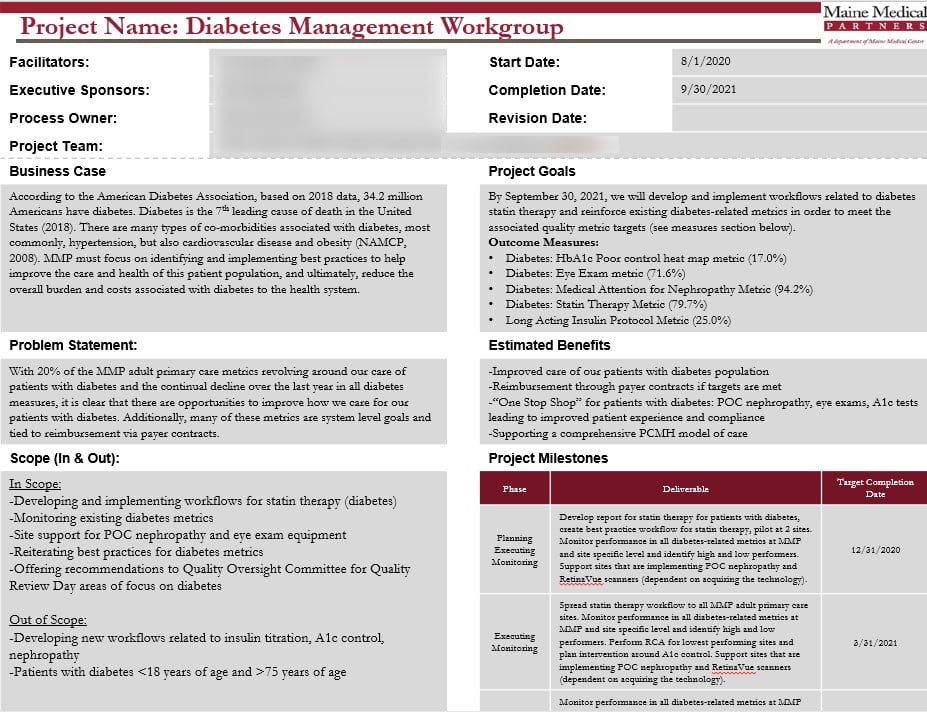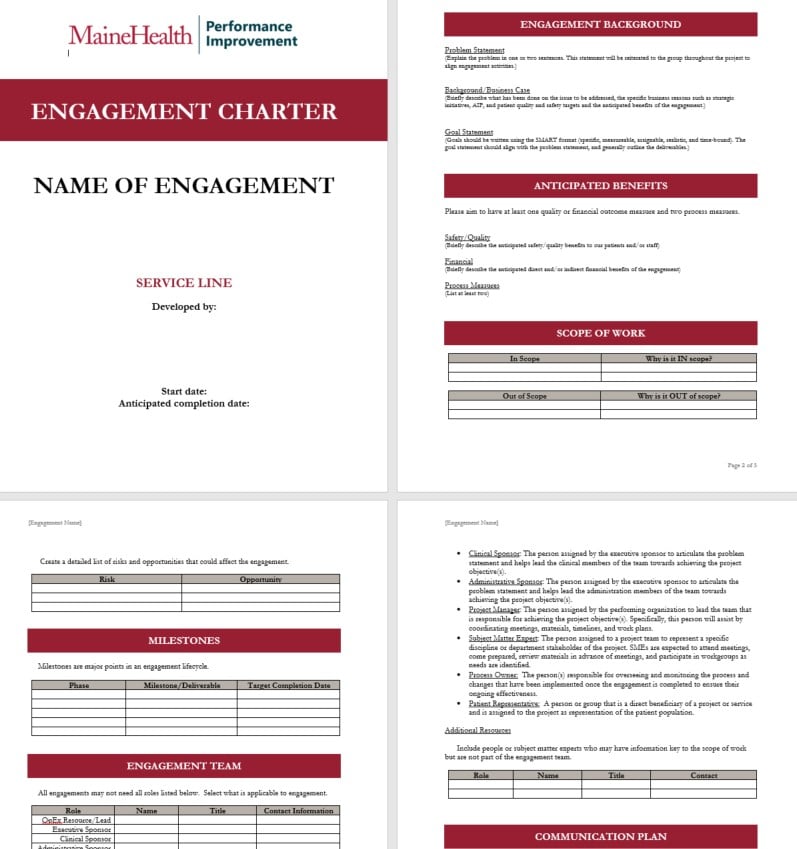Developing a Charter
Elizabeth Andrews, MPH, LSSBB
Improvement Specialist
MMC/P Performance Improvement Team
Learning Objectives:
- Express the importance of developing a charter
- Describe general components of a charter
- Determine when to use a formal charter versus a mini-charter
The development of a charter is one of the first steps in the Lean Six Sigma process and an important part of any quality or process improvement project or initiative. A charter will help to define your problem, objectives, and desired outcomes, as well as clearly outline necessary resources (including key team members) and project scope. “It serves as an informational contract that helps the team stay on track with the project objectives”1. The charter is the most important piece of documentation at the beginning of a project as it serves as a formal record of the authorization of the project, the needed resources, and offers a sense of direction and purpose of the project to leadership from the beginning of the project to the end.2
A project charter will ideally contain the following information:
- Project name and impacted department/service line/unit
- Business case – relationship to higher level strategic goals and initiatives, patient/organizational benefit, reason for prioritization
- Problem statement – include background information, how will this project address the issue at hand?
- Project goals – written in SMART (Specific, Measurable, Assignable, Realistic, Time-Related) goal format; be sure to include process and outcome measures as a way to track success of interventions
- Estimated benefits – include hard and soft savings when listing estimated benefits
- Project scope and possible risks or barriers – be specific to reduce scope creep. List what is in scope and out of scope. List what could be a potential barrier or risk that could affect the project.
- Key Stakeholders – list all groups of people who the specific project or intervention would affect or involve.
- Project Resources – this includes individuals that need to be involved in the project in some way. Include their role in the organization and role on the project team. Other resources must be documented as well, especially such as improvement specialist support, Information Technology support, analytics/reporting needs, etc.
- Project Milestones – generally broken down into phases and high level objectives, with a target completion date, supported by an implementation/action plan.3,4
As an Improvement Specialist, I use different charters depending on the complexity or duration of the project at hand. I utilize a “mini-charter” for projects of short duration and low complexity with few outcome goals and requiring minimal resources. The Diabetes Management Workgroup mini-charter (figure 1) is designed for a long-standing workgroup with consistent outcome measures that they are working to achieve year after year and only one or two non-complex intervention additions. The scope of the work remains large and the charter is necessary for the group members to stay on track.
Figure 1. Diabetes Management Workgroup Mini-Charter

An “Engagement Charter” or formal charter (figure 2) is generally used for more complex project engagements, such as a project that can have a multi-year impact, involve multiple stakeholders, and requires more structure for the key resources on the team.
Figure 2. MaineHealth Performance Improvement Formal Engagement Charter

To access a template for a “mini-charter” or “Engagement Charter” under the Project Planning documents on the MaineHealth Performance Improvement Tools and Templates sites, go here: Tools and Templates (mainehealth.org)
In closing, in order to better inform leadership and your project team, outline your project objectives, and realize your project benefits and necessary resources, it is helpful to start working on a charter once your project or intervention has been determined. It is a great tool for consistent reference to inform your project team of their roles and responsibilities and the original project focus. The charter documents the progress that has been made and is a living document that may be updated as frequently as necessary.
References
- Acuity Institute. (2016). Lean Six Sigma Black Belt eBook. Denver: Acuity Institute.
- Brown, A. S. (2005). The Charter: Selling your Project. PMI Global Congress. Newtown Square, PA: Project Management Institute. Retrieved from https://www.pmi.org/learning/library/charter-selling-project-7473
- (2021, May 7). UNC Institute for Healthcare Quality Improvement. Retrieved from UNC School of Medicine: https://www.med.unc.edu/ihqi/resources/project-charter/
- MaineHealth Performance Improvement. (2021, May 12). MaineHealth Performance Improvement Tools and Templates. Retrieved from MaineHealth Performance Improvement Tools and Trainings: https://home.mainehealth.org/2/MMC/CenterforPerformanceImprovement/SitePages/AllTools.aspx?web=1
Want to receive CME Credits? Click here
